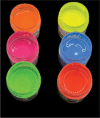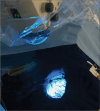Advanced fluorescence techniques in white matter fiber visualization for neurosurgical training
- PMID: 39640328
- PMCID: PMC11618733
- DOI: 10.25259/SNI_843_2024
Advanced fluorescence techniques in white matter fiber visualization for neurosurgical training
Abstract
Background: Neurosurgical training requires a deep understanding of brain anatomy, especially white matter fiber pathways, to enhance surgical precision. Traditional dissection techniques, such as Klingler's white matter dissection, are essential, but newer methods can provide additional clarity. This study explores the application of a fluorescent-assisted technique to improve the visualization and understanding of white matter fibers during neurosurgical training.
Methods: Twelve human brains were dissected following Klingler's protocol, with a focus white matter fiber pathway. Fluorescent alcoholic and oily solutions were applied to highlight the fibers. Ultraviolet (UV) blacklight and yellow monochromatic filters were used to enhance visualization. Dissections were documented through photography, and the effectiveness of the fluorescent techniques was analyzed.
Results: The application of UV light and fluorescent solutions enhanced the visualization of fiber pathways, particularly in regions with irregular fibers, such as the sagittal stratum. The alcoholic solution flowed along the anatomical paths of the fibers, aiding in their differentiation. The oily solution proved effective in specific areas, such as the internal capsule. The use of fluorescent techniques allowed for improved identification and anatomical detailing of major white matter tracts.
Conclusion: The fluorescent-assisted dissection technique significantly enhances the visualization of white matter fibers, offering a valuable tool for neurosurgical training. This method deepens anatomical understanding, provides a three-dimensional perspective of brain structures, and can improve surgical outcomes. The study suggests potential applications in other fields, such as glioma simulation and bypass patency testing.
Keywords: Fluorescent technique; Neurosurgery; Neurosurgical training; White matter fibers.
Copyright: © 2024 Surgical Neurology International.
Conflict of interest statement
There are no conflicts of interest.
Figures








References
-
- Agrawal A, Kapfhammer JP, Kress A, Wichers H, Deep A, Feindel W, et al. Josef Klingler’s models of white matter tracts: Influences on neuroanatomy, neurosurgery, and neuroimaging. Neurosurgery. 2011;69:238–52. - PubMed
-
- Choi CY, Han SR, Yee GT, Lee CH. Central core of the cerebrum. J Neurosurg. 2011;114:463–9. - PubMed
-
- Fernandez-Miranda JC, Pathak S, Engh J, Jarbo K, Verstynen T, Yeh FC, et al. High-definition fiber tractography of the human brain: Neuroanatomical validation and neurosurgical applications. Neurosurgery. 2012;71:430–53. - PubMed
-
- Fernández-Miranda JC, Rhoton AL, Jr, Kakizawa Y, Choi C, Alvarez-Linera J. The claustrum and its projection system in the human brain: A microsurgical and tractographic anatomical study. J Neurosurg. 2008;108:764–74. - PubMed
-
- Klingler J, Ludwig E. Atlas cerebri humani. Available from: https://karger.com/book/home/217798 [Last accessed on 2024 Jan 15]
LinkOut - more resources
Full Text Sources
